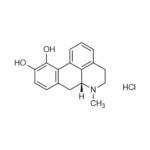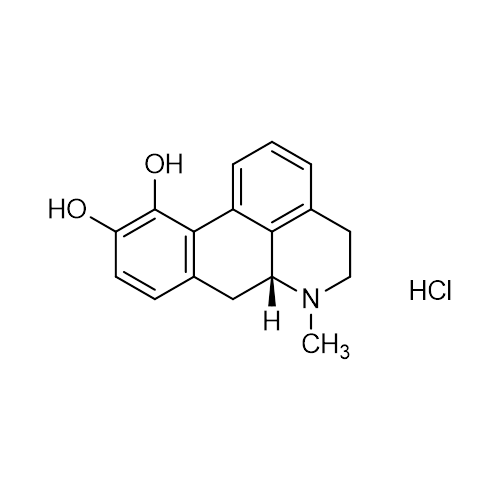| Product Name | Apomorphine HCl Hydrate |
| Description |
Dopamine Agonist |
| Purity | >98% (TLC); NMR (Conforms) |
| CAS No. | 41372-20-7 |
| Molecular Formula | C17H17NO2 • HCl ½H2O |
| Molecular Weight | 312.8 |
| Field of Use | Not for use in humans. Not for use in diagnostics or therapeutics. For in vitro research use only. |
Properties
| Storage Temperature | -20ºC |
| Shipping Temperature | Shipped Ambient |
| Product Type | Agonist |
| Solubility | May be dissolved in water (20 mg/ml) |
| Source | Synthetic |
| Appearance | Gray Powder |
| SMILES | CN1CCC2=C3C1CC4=C(C3=CC=C2)C(=C(C=C4)O)O.Cl |
| InChI | InChI=1S/C17H17NO2.ClH/c1-18-8-7-10-3-2-4-12-15(10)13(18)9-11-5-6-14(19)17(20)16(11)12;/h2-6,13,19-20H,7-9H2,1H3;1H/t13-;/m1./s1 |
| InChIKey | SKYZYDSNJIOXRL-BTQNPOSSSA-N |
| Safety Phrases |
Classification: Danger. Hazard Statements: H301 Precautionary Statements: P301 + P310 + P330 |
| Cite This Product | Apomorphine HCl Hydrate (StressMarq Biosciences Inc., Victoria BC CANADA, Catalog # SIH-619) |
Biological Description
| Alternative Names | Hemihydrate; R-(-)-6ab-aporphine-10,11-diol, hydrochloride; (R)-5,6,6a,7-Tetrahydro-6-methyl-4H-dibenzo[de,g]quinoline-10,11-diol, hydrochloride |
| Research Areas | Neurodegeneration, Neuroscience, Parkinson's Disease |
| PubChem ID | 9410 |
| Scientific Background | Apomorphine HCl Hydrate is a non-selective dopamine receptor agonist with established clinical use in Parkinson’s disease. It exhibits neuroprotective effects in preclinical models, including protection against MPTP-induced neurotoxicity. Apomorphine is used to manage motor fluctuations in Parkinson’s patients and serves as a model compound for studying dopaminergic signaling, neurodegeneration, and therapeutic interventions targeting dopamine pathways. |
| References |
1. Merck Index 14:746 2.Millan M.J., et al. (2002) J. Pharmacol. Exp. Ther. 303:791. 3. Grunblatt E., et al. (1999) Mov. Disord. 1999 14:612. 4. Auffret M., et al.( 2017) J. Neurol. Sci. 372:279. 5. Jenner P.and R Katzenschlager ( 2016) Parkinsonism. Relat. Disord. 33 Suppl 1:S13. |



Reviews
There are no reviews yet.